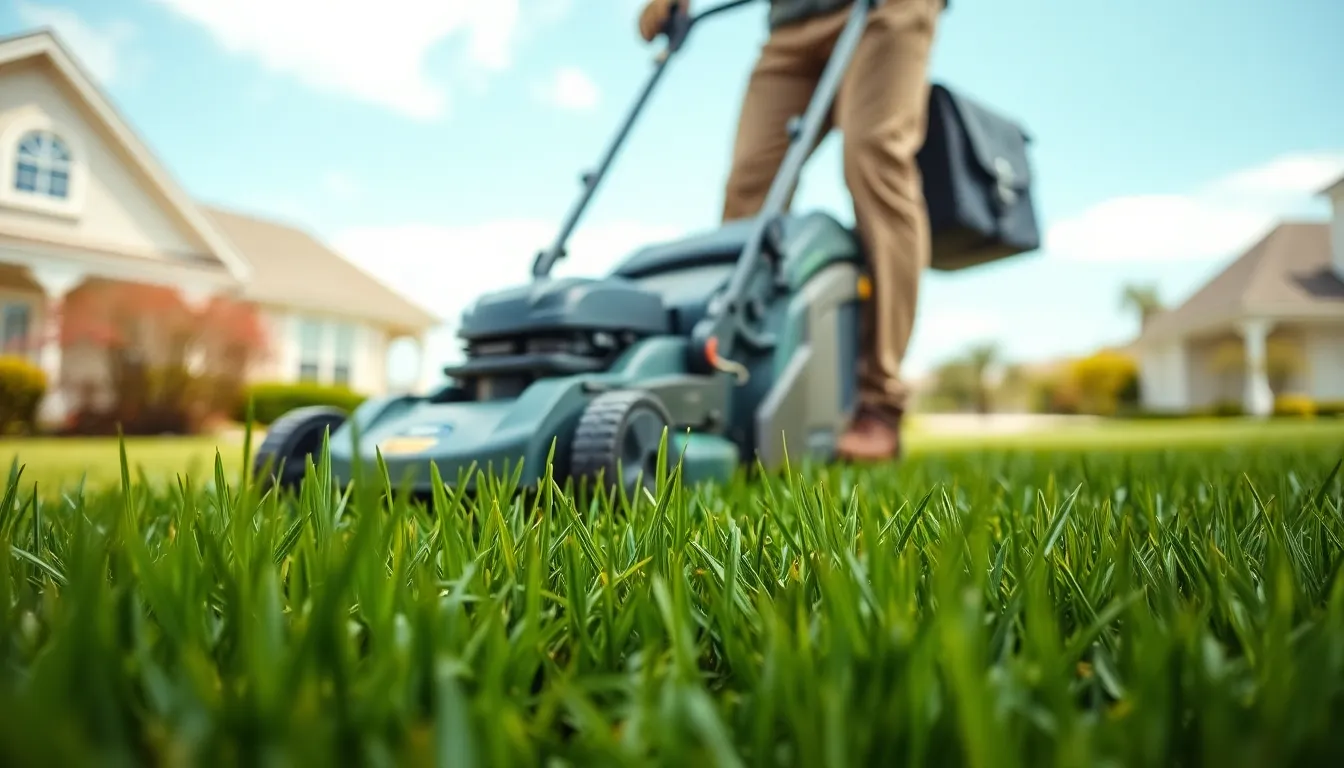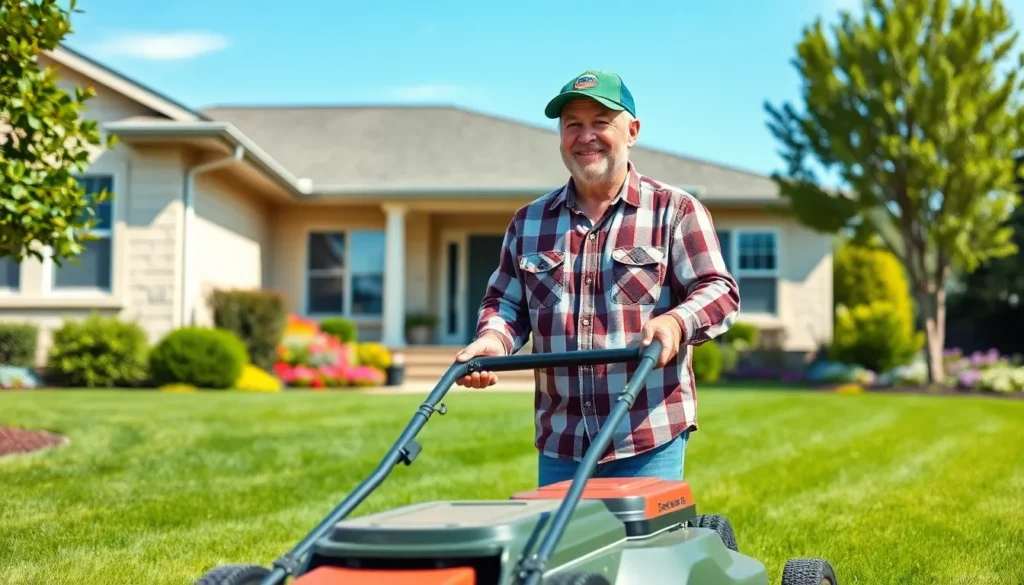A lush green lawn not only enhances the beauty of a home but also creates a welcoming environment. Proper lawn maintenance is essential for achieving that picture-perfect yard. Many homeowners may underestimate the effort required, but with the right knowledge and techniques, maintaining a vibrant lawn can be both manageable and rewarding.
From mowing and watering to fertilizing and pest control, each aspect plays a crucial role in keeping grass healthy and thriving. Understanding seasonal needs and regional climate variations can make all the difference. With a little dedication and the right tools, anyone can transform their lawn into a stunning outdoor oasis that elevates their property’s curb appeal.
Table of Contents
ToggleUnderstanding Lawn Maintenance
Lawn maintenance involves consistent practices aimed at keeping grass healthy and vibrant. Proper lawn care enhances both the aesthetics and functionality of outdoor spaces.
Importance of Lawn Maintenance
Lawn maintenance fosters healthy grass growth. Regular mowing, watering, and fertilizing create a lush lawn that supports biodiversity. A well-maintained lawn prevents soil erosion and improves air quality by producing oxygen. It serves as an outdoor recreation area, promoting family activities and community engagement. Understanding seasonal requirements ensures that grass receives appropriate care year-round, adapting to climate variations.
Benefits of a Well-Maintained Lawn
A well-maintained lawn provides numerous advantages. Aesthetically, it enhances curb appeal, increasing property value by up to 15% according to the National Association of Realtors. Healthy lawns improve outdoor comfort by providing cooling effects during hot months. They also contribute to reducing noise pollution. Moreover, well-maintained grass can act as a natural filter, purifying the air and capturing stormwater runoff effectively. A vibrant outdoor space promotes relaxation, encouraging outdoor activities and family gatherings.
Common Lawn Care Practices

Common lawn care practices play a vital role in maintaining a healthy and attractive yard. Key operations such as mowing, watering, and fertilization contribute to robust grass growth and overall lawn health.
Mowing Techniques
Mowing requires specific techniques to promote healthy grass.
- Height Matters: Grass height should remain between 2.5 to 4 inches to support root health and shade soil, which inhibits weed growth.
- Frequency: Mowing every 1 to 2 weeks during the growing season maintains an even appearance while preventing stress on the grass.
- Sharp Blades: Keeping mower blades sharp ensures clean cuts, which minimize damage and disease susceptibility.
- Pattern Variation: Altering mowing patterns weekly can prevent soil compaction and promote upright growth.
Watering Guidelines
Watering guidelines dictate optimal moisture levels for healthy grass.
- Timing: Early morning irrigation, preferably between 6 AM and 10 AM, reduces evaporation loss and fungal diseases.
- Frequency: Watering 1 to 1.5 inches per week, whether through rainfall or irrigation, encourages deep root development.
- Drainage Checks: Assessing soil drainage improves watering efficacy and helps determine if adjustments are necessary.
- Soil Moisture: Using a soil moisture meter can provide accurate insights into when watering is needed.
Fertilization Methods
Fertilization methods replenish essential nutrients for grass vitality.
- Type of Fertilizer: Balanced fertilizers, such as those with a 10-10-10 NPK (nitrogen, phosphorus, potassium) ratio, support overall growth.
- Application Timing: Timing applications in spring and fall aligns with grass growth cycles for maximum effect.
- Soil Testing: Conducting soil tests provides specific nutrient needs, allowing for targeted fertilization.
- Broadcasting Techniques: Using a spreader for even distribution ensures consistent coverage and minimizes buildup in certain areas.
Seasonal Lawn Maintenance Tips
Proper lawn maintenance varies throughout the year. Following seasonal tips optimizes care efforts for a lush and healthy lawn.
Spring Care
Spring marks a crucial time for lawn rejuvenation. Focus on these key actions:
- Aerate the soil: Aeration reduces compaction and enhances air circulation.
- Fertilize: Apply a balanced fertilizer rich in nitrogen to promote growth.
- Seed: Consider overseeding to thicken the turf and repair bare patches.
- Weed control: Implement pre-emergent herbicides to prevent weed establishment.
- Mowing: Begin regular mowing, maintaining grass height at 2.5 to 4 inches.
Summer Strategies
Summer requires specific strategies to cope with heat and drought. Key practices include:
- Watering: Ensure consistent watering of 1 to 1.5 inches weekly, focusing on early mornings.
- Mowing frequency: Mow every 1 to 2 weeks, adjusting height to encourage shade on grassroots.
- Fertilization: Apply slow-release fertilizers for steady nutrient absorption.
- Pest control: Monitor for pests and treat infestations promptly with targeted solutions.
Fall Preparation
Fall is essential for preparing the lawn for winter. Implement these steps:
- Aerate again: Fall aeration improves root development and nutrient absorption.
- Overseed: Seed cool-season grasses to ensure vibrant growth in the spring.
- Fertilize: Use high-potassium fertilizers to strengthen grass before dormancy.
- Leaf management: Regularly rake leaves to prevent mold growth and block sunlight.
Winter Protection
- Avoid foot traffic: Minimize walking on dormant grass to prevent damage.
- Mulch: Apply a thin layer of mulch to protect roots from freezing temperatures.
- Prevent thawing: Cover with a tarp during temperature fluctuations to prevent thawing and refreezing damage.
- Plan for spring: Gather materials and resources for spring projects, including soil tests and seed selections.
Pest and Weed Management
Pest and weed management significantly impacts lawn health and appearance. Implementing effective strategies ensures a thriving outdoor environment.
Identifying Common Pests
Identifying common lawn pests is crucial for effective management.
- Grubs: These larvae feed on grass roots, causing patches and thinning. Look for wilting areas and check the soil for white or grayish larvae.
- Chinch Bugs: These small black insects suck moisture from grass blades, creating brown spots. Observation during hot weather often reveals the problems they cause.
- Armyworms: These caterpillars consume large sections of grass, especially in spring and fall. Signs include chewed blades and green droppings.
- Billbugs: These beetles damage lawns by feeding on stems and roots. Noticing brown patches in areas where moisture concentrates often indicates their presence.
- Aphids: These tiny insects cluster on new growth, leading to curling or stunted grass. Checking under leaves during warmer months helps in detection.
Recognizing pest signs early facilitates prompt treatments, ensuring grass health and vitality.
Effective Weed Control Methods
Effective weed control methods enhance lawn aesthetics and promote grass growth.
- Mulching: Applying a 2-3 inch layer of organic mulch suppresses weeds while retaining moisture in the soil. It’s particularly effective around flower beds and trees.
- Hand Pulling: Manually removing weeds when they are small prevents seed production. This method is best for controlling isolated weeds.
- Herbicides: Selective herbicides target specific weeds without harming grass. Applying pre-emergent herbicides in early spring prevents new weed growth.
- Cultural Practices: Improving lawn density through overseeding and proper fertilization reduces weed competition. Regular mowing at an appropriate height (2.5 to 4 inches) also discourages weed establishment.
- Soil Health: Maintaining healthy soil through aeration and regular testing promotes strong grass growth and minimizes weed proliferation. Healthy grass can outcompete weeds for nutrients and water.
Implementing these weed control methods keeps lawns healthy while reducing pest and weed outbreaks.
Tools and Equipment for Lawn Maintenance
Proper lawn maintenance requires specific tools and equipment to achieve optimal results. Both essential tools and advanced equipment play vital roles in maintaining a healthy and attractive lawn.
Essential Tools for Beginners
- Lawn Mower
Lawn mowers maintain grass height, ensuring a uniform look. Choose between rotary or reel mowers based on lawn size and personal preference.
- String Trimmer
String trimmers tackle areas mower can’t reach, such as edges and tight spots. They provide a polished appearance alongside the lawn edges.
- Rake
Rakes gather leaves, grass clippings, and debris. This tool aids in soil aeration and promotes healthy grass growth.
- Spreader
Spreaders evenly distribute fertilizers and seed. They ensure proper coverage, preventing patchy growth or nutrient overload.
- Hose and Sprinkler
A flexible hose and sprinkler system help establish a consistent watering schedule. They maintain soil moisture levels crucial for grass health.
- Lawn Fork
Lawn forks aerate soil, allowing water and nutrients to penetrate. Regular aeration prevents compaction and promotes root growth.
Advanced Equipment for Lawn Care
- Robot Lawn Mower
Robot mowers automate the mowing process, saving time and effort. They operate on programmable schedules, ensuring regular maintenance.
- Core Aerator
Core aerators extract plugs of soil from the lawn to improve air circulation and water penetration. This machine enhances root health and overall lawn vigor.
- Power Seeder
Power seeders simplify overseeding by mechanically embedding seeds into the soil. This device enhances seed establishment and encourages denser turf.
- Fertilizer Injector
Fertilizer injectors deliver liquid fertilizers directly to the roots. They promote rapid nutrient absorption and healthier lawn growth.
- Pest Control Sprayer
Pest control sprayers efficiently apply insecticides and herbicides. They help manage pest outbreaks while limiting chemical exposure.
- Dethatcher
Dethatchers remove excess thatch, promoting healthy turf growth. They restore lawn health by improving nutrient and water absorption.
A well-maintained lawn is more than just a visual delight; it’s an investment in a home’s overall appeal and functionality. By understanding and applying essential lawn care practices, homeowners can create a vibrant outdoor space that fosters relaxation and enjoyment.
With consistent attention to mowing, watering, and pest management, achieving a lush lawn becomes a rewarding experience. Utilizing the right tools and techniques tailored to specific seasonal needs ensures that grass remains healthy throughout the year.
Ultimately, a thriving lawn not only enhances property value but also contributes positively to the environment and community. Embracing these lawn maintenance strategies paves the way for an inviting and sustainable outdoor haven.



